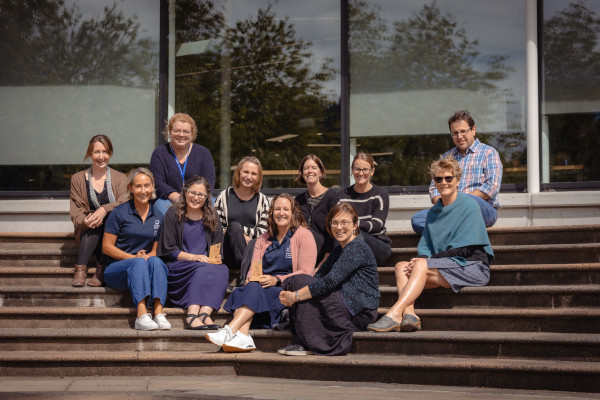- Tūhono home Hoki ki Tūhono
-
- Staff Directory
- Chief Executive Office Auckland International Office Corporate Services Finance Campus Services Functions and Catering Information Systems and Support Marketing, Communications and Engagement Learner Journey Academic Registry International Learner Services Te Punaka Ōwheo
- Learner Experience Academic Excellence Central Campus College of Community Development and Personal Wellbeing College of Engineering, Construction and Living Sciences College of Health College of Work Based Learning Open Education Resource/OERu Research and Postgraduate Studies Te Maru Pumanawa | College of Creative Practice and Enterprise
- Māori Development and Kaitohutohu Office People, Culture & Safety People and Culture Childcare Centre Te Ama Ako | Learning and Teaching Development Wellbeing and Safety Auckland Staff Directory Executive Office Academic Corporate Services Marketing and Business Development Human Resources Campus Quality and Programme Development
-
 Our people make a better world
Our people make a better world
We build the capabilities of individuals, organisations and communities and help them to realise their potential.
Staff Directory
-
- Tools
- Academic Integrity Declaration Form AIC Applications Dashboard Approved Programmes Approved Programme Fees Centralised Assessement Repository Chemwatch CMS - Tūhono & StudentHub updates Course Evaluation and Surveys CRM Applications CRM customer service hub Delegations policy/process Disability and Neurodiversity Dynamics 365 (CRM) EBS Ontrack EBS Report Email Security Personal Portal Employment Matters / Solarworkplace eTaxi eTV
- Financial Variance Reporting Hidden Disabilities Sunflower programme FCM travel intranet InPlace International entry requirements Knowledgebase articles Learner Capability Learner Support Dashboards Linkedin Learning Log a job with Marketing Login as an applicant Microsoft 365 Moderation App Moodle OP Docs OP Docs - Publishing OP Image Libraries Performance Excellence Portal Product Evaluation Panel
- Policy Library Privacy Programme and Course Design and Development Qualtrics XM RDS Remote Access Support Portal Research Database Robertson Library Staff FAQs about Graduation Status of Programmes Student Hub (Kāpehu demonstration view) Study Abroad info for learners Te Whare (Te Pūkenga intranet) Tūhauora I Wellbeing resources Uniprint Vault Webexpenses Auckland Tools
-
 Vault
Had an accident or near miss?
Log it here
Vault
Had an accident or near miss?
Log it here
-
- Communities
- Community AI Steering Committee Ally Network EBS Community of Interest EdTech Champions Health & Wellbeing Research Internal Evaluation Neurodiversity Professional Team Professoriate Proud@OP Student Support Website Advisory Group Web Champions Working under the Rainbow Project Learner Capability Trade Training Centre
- Committee Academic Committee Animals@OP Diversity and Equity Doctor of Professional Practice Committee Kaunihera Whakahaere - Leadership Council Internal Evaluation Learning & Teaching Leadership Team Library Committee Mental Health and Wellbeing Advisory Group Otago Polytechnic Board of Directors Pastoral Care Code Committee Programme Approvals Committee Research and Postgraduate Committee Research Ethics Committee Staff Subcommittee
- Think Tanks Mātauraka Our learners achieve educational success Pūtea Our financial success Tākata Our people, our team, our community Tiriti Our active commitment as a Treaty partner Tūroa Our commitment to be a sustainable and responsive organisation
-
 Create a community
Create a community
Do you have a community, committee or project that you'd like represented here?
Communities
-
- About OP
- Keep up to date All news All events All notices All blogs Share your info Create a news article Create an event Create a notice Create a blog
- Community and Partnerships Alumni and friends Education Foundation Operational information Academic calendar 2025 Academic calendar 2026 Current vacancies Dunedin campus map Our policies Te Whare (Te Pūkenga intranet) Topical FAQs
- Who we are Commemorative sites Māori Strategic Framework Our history Our strategic priorities Pasifika Strategic Framework (2025-2030) Vision and Values Working for us OP job opportunities Wellbeing Calendar Working at OP
-
New Zealand: 0800 762 786
contact us
International: +64 3 477 3014
Homebirth outcomes and postnatal experiences in Canterbury (HOPE) study
Author: Violet Clapham
Supervisors: Suzanne Miller Sally Baddock
Clapham, V. (2023). Homebirth outcomes and postnatal experiences in Canterbury (HOPE) study. (Unpublished document submitted in partial fulfilment of the requirements for the degree of Master of Midwifery). Otago Polytechnic, New Zealand. https://doi.org/10.34074/thes.6307
Abstract
Background: Homebirth and home postnatal outcomes are not well described within midwifery literature. What evidence exists supports the high value of continuity of midwifery care and the positive experiences of homebirth and a home postnatal course. What is considered ‘normal’ in relation to newborn weight change is also poorly understood and is informed almost entirely by institutional postnatal care outcomes. Despite implementation of policies protecting exclusive breastfeeding for newborns, breastfeeding outcomes in Aotearoa New Zealand are sub-optimal at six weeks postpartum.
Aim: To describe neonatal outcomes in relation to breastfeeding and newborn weight change following homebirth in Aotearoa New Zealand and to understand how women’s experiences of a home postnatal course with continuity of midwifery care following homebirth might contribute to understanding these outcomes.
Methods: This research employed a mixed methods triangulation design consisting of concurrent collection of equally weighted quantitative and qualitative data sets. There were two sets of participants: eight focus group participants (50% primiparous) and 90 survey participants (21% primiparous). Reflexive thematic analysis was used to identify key qualitative themes from focus group discussions with eight homebirth parents in Christchurch, New Zealand. Descriptive statistical analysis was applied to report quantitative homebirth postnatal outcomes from survey data of 90 homebirths in the Canterbury/West Coast region. This research was underpinned by a critical realist framework that enabled exploration of the complex social and cultural factors that shape midwifery practice and maternal and neonatal health outcomes.
Findings: Women described the importance of support and creating a safe space for birth and early breastfeeding. Homebirth was described as a shared, empowering experience, and this positive birth experience had a direct impact on women’s postnatal experience. Continuity of midwifery care was a key factor in building maternal confidence and trust in normal physiology and progress. There was a high rate of physiological birth (both of baby (100%) and placenta (91%)) and low rates of postpartum haemorrhage >1000 mls (3%) and 3rd degree perineal tearing (1%). Most women used a range of labour coping strategies, and most gave birth in an upright position (92%). The postpartum hospital transfer rate was 7%. Babies born at home experienced a mean of 127 minutes of uninterrupted skin-to-skin contact with their mother after birth and on average initiated breastfeeding 36 minutes after birth. Babies fed for a mean 52 minutes during their first breastfeed and went on to establish a high rate of exclusive breastfeeding (95%) at discharge from midwifery care. Women described their commitment to establishing breastfeeding and some women described the need for perseverance in working through initial breastfeeding issues to achieve their breastfeeding goals. Nearly half (42%) of the babies born at home were at or above their birthweight at one week of age. The mean weight change at one week was -0.5% from birthweight (M= 21g loss, SD 155g). All women received full continuity of postnatal care from their LMC midwife and received a mean of 10 postnatal home visits over the six week postnatal period. The postnatal outcomes data, while not relating to the same families, affirms that such an environment can produce excellent conditions for optimal maternal and neonatal wellbeing.
Discussion: Homeborn babies were able to thrive instinctively when they were allowed to take the lead on initiating feeding and resting periods. Reported weight change at one week found minimal weight loss and there were high rates of exclusive breastfeeding at six weeks. These research findings suggest that breastfeeding intervention for healthy term neonates is rarely needed, and mother/baby dyads will usually achieve breastfeeding success in a supportive environment with continuity of care.
Conclusions: In this study, homebirth outcomes were consistently positive and laid the foundations for a positive postnatal course. Women felt empowered by their homebirth and home postnatal experiences and embraced a trust in their breastfeeding journey that enabled instinctive thriving for babies through the postnatal phase. This was enabled and enhanced by continuity of midwifery care, which women valued highly. Home born babies often lost minimal weight in the first week and they maintained high rates of exclusive breastfeeding through the first six weeks of life. These findings should encourage a challenge to the current approach to early postnatal support provided in an institutional environment.
Keywords
homebirth, postnatal, breastfeeding, newborn weight, continuity, New Zealand
Licence
A copy of the thesis is publicly available under a Creative Commons Attribution Non-Commercial No Derivatives licence CC BY-NC-ND 4.0 International
![]()